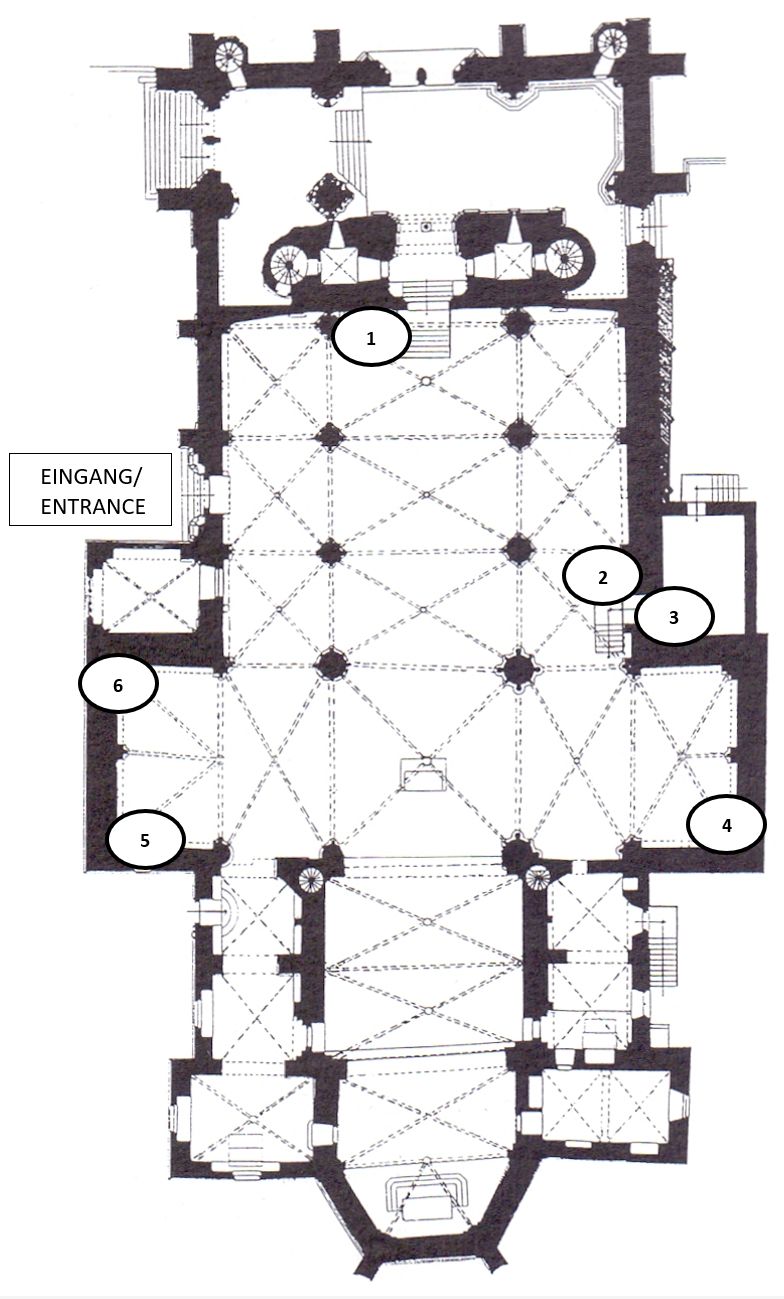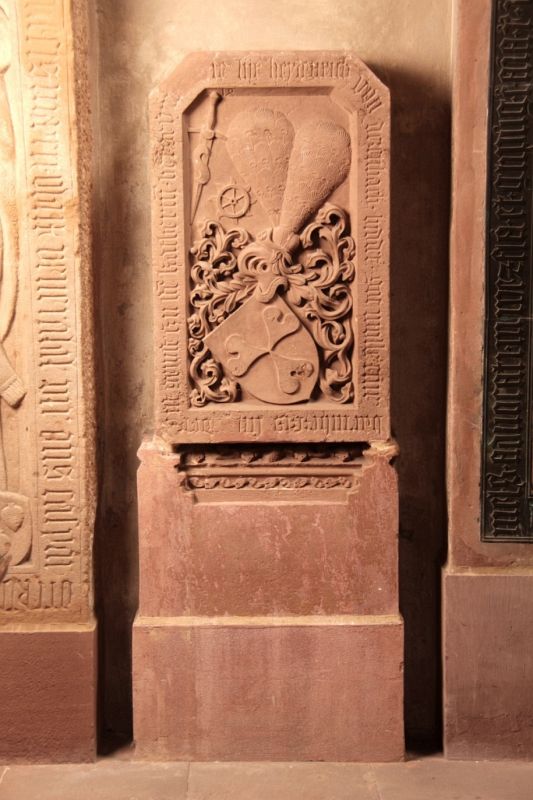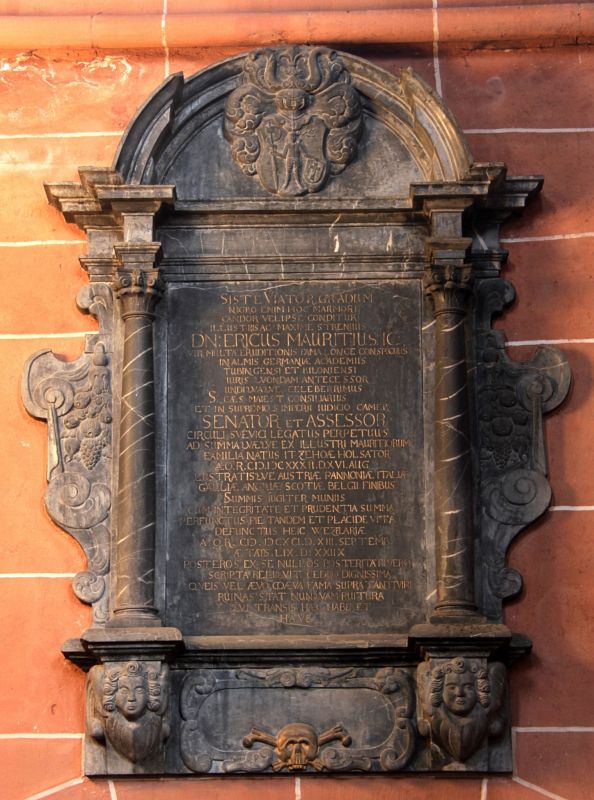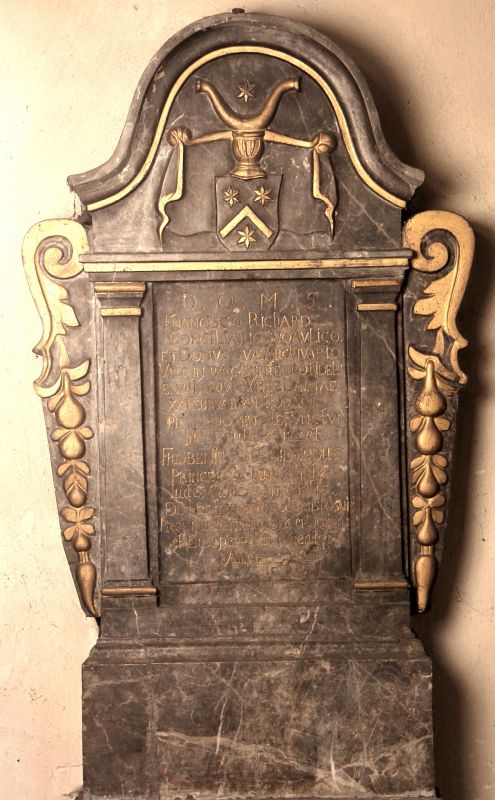53 Gravestones and Epitaphs in Wetzlar Cathedral
Dear visitors,
There are 53 epitaphs in the cathedral, in the “Heidenhof”, in the outside area on the north side and in front of the outside entrance to the choir area. These epitaphs, some of which were once tomb slabs, are no longer located in their original location. The memory of the deceased stretches from 1362 to 1792. The 53 epitaphs give a good insight concerning the development of a mourning culture over about four centuries. However, the epitaphs only give an insight into the privileged citizens of Wetzlar. The placement of the tombstones and epitaphs in the Wetzlar Cathedral was exclusively reserved for the upper middle classes. It was, and this can be seen from the epitaphs of the members of the Imperial Chamber of Justice, always a question of money whether one could secure a memento in Wetzlar Cathedral by an elaborately designed plate.

For 6 selected epitaphs you will find detailed information about the deceased in Wetzlar Cathedral via a QR code.
- QR 1: Epitaph of Franz Richard, the only servant among the 53 epitaphs of citizens of Wetzlar
- QR 2: Epitaph of Maria Franziska von Heeser, wife of the imperial postmaster
Anselm Franz Joseph von Löhr - QR 3: Epitaph of Erich Mauritius, the only judge at the Imperial Chamber Court, the highest court in the Holy Roman Empire of the German Nation, based in Wetzlar from 1689 to 1806, who dealt with legal issues relating to witchcraft
- QR 4: Epitaph of John Theis, the only craftsman in the circle of important Wetzlar citizens
- QR 5: Epitaph of Heydenreich von Dernbach, medieval pilgrim to he Catherine’s Monatery on Mount Sinai
- QR 6: Epitaph of Johannnes Konrad Hertstein, Catholic cleric with two dates of death (Julian and Gregorian calendar)
1. Heydenreich von Dernbach, year of death 1490, medieval pilgrim to St Catherine's Monastery on Mount Sinai

The epitaph of Heydenreich von Dernbach has two special features. Firstly, it is reported that Heydenreich von Dernbach made a pilgrimage to St Catherine's Monastery on the Sinai Peninsula in the 15th century and secondly, the epitaph leaves the actual date of death open. This strengthens the assumption that Heydenreich von Dernbach's epitaph was made during his lifetime. Heydenreich von Dernbach returned from a visit to St Catherine's Monastery in the Holy Land in 1443.
Pilgrimages to the Holy Land were not unique at the end of the Middle Ages. From the second half of the 15th century onwards, there was "package tourism" to Jerusalem to the Church of the Holy Sepulchre and St Catherine's Monastery. Nobles in particular were able to become Knights of the Holy Sepulchre after paying a "fee" at the Church of the Holy Sepulchre in Jerusalem. This gave them a high reputation on their return home. This could have been a particular motivation for Heydenreich von Dernbach.
Heydenreich von Dernbach was born in 1434. His year of death is not noted on the epitaph. In a 15th century necrology of St Mary's Abbey in Wetzlar, a passage indicates a possible year of death of 1490.
The epitaph shows a coat of arms with three shamrocks. Two large peacock feathers are attached to a helmet. Plants entwine the helmet and the coat of arms. In the upper left corner is a sword with a sword belt. The wheel underneath, with six spokes and thorns on its tread, symbolises the pilgrimage.
Translation of the text passages on the epitaph:
Here lies Heydenreich von Dernbach, (he) asks God to be merciful to him
;
he has been to St Catherine's on Mount Sinai...
Lower edge of upper margin
14
Further information: see Jürgen Wegmann: Der Wetzlarer Dom - Epitaphien und Grabplatten, Baden-Baden 2018. ISBN 978-3-8288-4142-0, eISBN 978-3-8288-7003-1
2. Johannes Theis, year of death 1651 or 1681, the only craftsman in the circle of important Wetzlar citizens

The epitaph of Johannes Theis is a fine example of a pictorial representation of the memory of a deceased person. Little is known about Johannes Theis. The only personal information relates to his age and the year of his death. There is no consensus on the year of death. Some sources interpret the year in the left-hand margin as 1681, while others assume 1651. Theis is said to have died at the age of 71. The remaining passages in the text refer to two biblical passages. The text is written in German, reflecting the influence of the Reformation and the Lutheran translation of the Bible. The epitaph shows a praying man kneeling in front of a cross with the crucified Christ. It is striking that the left-hand side of the picture is left blank. There is no explanation for this. It is also interesting to note that the portrait of the deceased has been painted in a contemporary style. This can be recognised by the coat, the coat collar and the goatee. The upper part of the coat of arms shows a bull's head with a plane between its horns, which in turn supports the assumption that Johannes Theis could have been a craftsman from Wetzlar.
Translation of the text passages on the epitaph:
Come unto me, all ye that labour and are heavy laden. I will give you rest.
Matth. am XI cap. Ao 1651/1681?.
(Under the relief:)
If we live, we live unto the Lord; if we die, we die unto the Lord; therefore whether
we live or die, we are the Lord's. Rom.am 14. cap.
Johann Theis was 71 years old.
Further information: see Jürgen Wegmann: Der Wetzlarer Dom - Epitaphien und Grabplatten, Baden-Baden 2018. ISBN 978-3-8288-4142-0, eISBN 978-3-8288-7003-1
3. Johannes Konrad Hertstein, year of death 1652, Catholic cleric with two dates of death (Julian and Gregorian calendar)

The epitaph of the Catholic cleric Johannes Conrad Hertstein has a special feature and its pictorial representation is a very good example of the mourning culture of the Catholic community in this shared church. [for info see: https://en.wikipedia.org/wiki/Simultaneum]
Death in relation to the calendar:
Johannes Conrad Hertstein came from Andernach and was Dean of St Mary's Abbey at Wetzlar Cathedral from 1632 to 1652. He was born in Andernach in 1585/86; he died on 4 October 1652 at the age of 66. According to another source, he died in Wetzlar on 24 September 1652. These two different dates of death are obviously due to different calendars. The date of death mentioned in the inscription is based on the new Gregorian calendar introduced by Pope Gregory XIII in 1582. While the Julian calendar refers to the date of death as 24 September 1652. In 1652, the day of death was therefore a relative date, which posed major problems for Godfather Death. This is because the new Gregorian calendar was not yet in use everywhere in 1652.
The epitaph is no longer complete, the lower edge has an inscription missing. This can also be recognised by the coat of arms shield, only three quarters of which is still visible. A round arch is recognisable in the background of the figurative depiction. The deceased is holding a chalice. The sacred robe of the dean of the monastery is very vividly worked out. The relief-like depiction of the head with goatee and moustache, the arrangement of the hairstyle and finally the facial features with the wrinkles are evidence of an expressive portrait. The coat of arms shows a shield in the centre. The remaining space is squared and shows 3 bars at the top left and bottom right, and a seated bear at the top right and bottom left.
Translation of the text passages on the epitaph:
The highly honourable, very distinguished and excellent Johannes Konrad Hertstein
from Andernach, dean and church warden of this church, died on 4 October 1652.
He lived for 66 years.
Further information: see Jürgen Wegmann: Der Wetzlarer Dom - Epitaphien und Grabplatten, Baden-Baden 2018. ISBN 978-3-8288-4142-0, eISBN 978-3-8288-7003-1
4. Erich Mauritius, year of death 1691, the only judge at the Imperial Chamber Court, the highest court in the Holy Roman Empire of the German Nation, based in Wetzlar from 1689 to 1806, who dealt with legal issues relating to witchcraft

The first epitaph of a member of the Imperial Chamber Court belongs to the assessor Erich Mauritius, who died in 1691. Erich Mauritius was born on 10 August 1632 in Itzehoe. He studied law at the universities of Wittenberg, Frankfurt/Oder, Giessen and Tübingen. In 1654, at the age of 22, he was awarded his doctorate in Tübingen. He then took up the post of tutor to the pupils of a collateral line of the Dukes of Schleswig-Holstein in Plön and travelled with his pupils to Paris and Vienna, where he lived for several years. He later travelled to England, Italy and the Netherlands on educational trips. The epitaph also lists other countries he travelled to, such as Hungary, Scotland and Belgium. He came to Heidelberg in 1659. In 1660, he was appointed professor of constitutional and feudal law at the Tübingen Faculty of Law.
During this time, Mauritius became known for his legal studies and writings on witch trials. In 1664, he presented a highly regarded dissertation on witchcraft and witch trials at the University of Tübingen. It is interesting to note his undoubted belief in witches and the power of the devil. In 1665, Mauritius moved to the University of Kiel, where he became the first professor at the Faculty of Law. Here, too, he was involved with legal reports in connection with witch trials. His reports show that he did not abandon his belief in witches in Kiel either, but also advised caution and moderation in the question of guilt in the interests of the accused.
In 1671, the Swabian district presented him as assessor at the Imperial Chamber Court in Speyer, where he began his work as a judge a year later. Shortly afterwards, Emperor Leopold appointed him Imperial Councillor. In 1689, he fled from Speyer to Frankfurt am Main to escape the French troops, before moving to Wetzlar a year later. He died there on 1 September 1691. The assessor Erich Mauritius was the only judge who dealt intensively with questions of witchcraft.
In his capacity as a judge at the Imperial Chamber Court, Erich Mauritius would today be described as a "perpetrators at their desks". Although in his writings on witchcraft he urged moderation among accused women and men when it came to confessions extracted through torture, he produced legal writings that led to death by fire of accused persons based on his expert opinions.
The epitaph is bordered on the right and left by Corinthian columns. A coat of arms is depicted in the upper section, showing a standing knight with shield and lance in the centre. In the lower section, a skull can be seen, bordered on the side by two angel heads. The extensive text in Latin is characterised by a high regard for the assessor Erich Mauritius. However, the epitaph contains no references to his serious expert work in connection with witch trials, which led to the death of the accused men and women.
Translation of the text passages on the epitaph:
Remain standing (slow your gait), traveller, for even honesty itself is buried beneath this black marble, namely the respected and particularly capable Dr. Erich Mauritius, a man widely distinguished by his reputation for great scholarship and once professor of law at German universities in Tübingen and Kiel, counsellor to his Imperial Majesty, senator and assessor at the highest court of the Holy Empire and permanent envoy to the Swabian Circle. He was born in Itzehoe in Holstein of the Mauritian family on 16 August 1632 for the highest tasks, and, after travelling through Austria, Hungary (Pannonia), Italy, France (Gaul), England, Scotland and Belgium, he immediately administered his high offices with the greatest care and prudence and finally died piously and peacefully here in Wetzlar on 13 September 1691, aged 59 years and 28 days old and without any descendants of his own, but he left behind for posterity writings that were extremely worthy of immortality and through which a lasting fame will never fade after the death of such an important man. You who pass by, remember this and farewell.
Further information: see Jürgen Wegmann: Der Wetzlarer Dom - Epitaphien und Grabplatten, Baden-Baden 2018. ISBN 978-3-8288-4142-0, eISBN 978-3-8288-7003-1
5. Franz Richard, year of death 1721, the only servant among the 53 epitaphs of citizens of Wetzlar

This epitaph in Wetzlar Cathedral has a special significance that cannot be categorised with the other epitaphs. It is the epitaph of Franz Richard, who died on 20 February 1721. The memorial plaque was commissioned by the chamber judge Frobenius Ferdinand Prince of Fürstenberg for his servant, the court counsellor and house archivist. Franz Richard was not a functionary of the Imperial Chamber Court. In this respect, this epitaph is something special. The esteem in which the highest functionary of the Imperial Chamber Court (from 1718-1722) held his servant by means of an epitaph in Wetzlar Cathedral must have been based on a special relationship of trust or special merit. The form in which this relationship was expressed or what the special merits consisted of are not known.
The epitaph contains a coat of arms in the upper section, on which a chevron with three stars is depicted. Above the coat of arms is a helmet surmounted by two horns with a star in the centre.
Translation of the text passages on the epitaph:
D.O.M.S. (Deo Optimo Maximo Sacrum). Dedicated to the best and highest God.
Frobenius Ferdinand Fürst von Fürstenberg, judge at the Imperial Chamber Court, has erected this monument in mourning to his court councillor and house archivist Franz Richard, a blameless, reliable, learned man like few others, who died piously in the Lord in Wetzlar on 20 February 1721 and is buried here, his best steward. Lord, grant him eternal rest, and may eternal light shine upon him. Amen.
Further information: see Jürgen Wegmann: Der Wetzlarer Dom - Epitaphien und Grabplatten, Baden-Baden 2018. ISBN 978-3-8288-4142-0, eISBN 978-3-8288-7003-1
6. Maria Franziska von Heeser, year of death 1727, wife of the imperial postmaster Anselm Franz Joseph von Löhr

While the majority of the epitaphs of the members of the Imperial Chamber Court were elaborately designed and reflected the pronounced sense of status in the memorial plaques, there are a few epitaphs that refer to the special fates of the deceased. Class barriers played no role in these cases. These include in particular wives or children of members of the Imperial Chamber Court. The wives of the members of the Imperial Chamber Court played a special role.
Maria Franziska von Heeser, who died in 1727, was one such person. Honoured is the wife of Anselm Franz Joseph von Löhr, court counsellor in Mainz and imperial postmaster in Wetzlar. Mrs von Heeser, who died in childbirth on 24 May 1727 at the age of just 28, followed her deceased daughter after a long and difficult struggle. Her marriage to the court counsellor and postmaster lasted only one year.
The epitaph is elaborately designed and shows two coats of arms in the upper section. On the left shield are three lilies and the right shield shows the Lamb of Christ with a crucifix depicted on a banner. Above the helmets crowning the coats of arms are a person with a sword on the left and a pair of angel wings on the right. In the lower area, a skull with two crossed bones is recognisable.
Translation of the text passages on the epitaph:
Stop, traveller, and look at the self-sacrificing love and respect of a wife.
For you see here Maria Franziska von Heeser, most excellent daughter of the highly-born, highly-respected and highly-educated Mr Philipp Nikolaus von Heeser, formerly the very capable director of the chancellery of the most illustrious Prince of Nassau-Hadamar; at the time when she was married to the highly-born and highly-respected Mr Anselm Franz Joseph von Löhr, the elected court councillor at Mainz and imperial postmaster at Wetzlar, her most beloved husband; the first fruit of their mutual love and pledge of their marital fidelity came forth in restless anxiety, she lamented in pain: then the young mother, for whom the foetus was too heavy, subject to all too long struggles, died together with her little daughter, after giving birth to her child, herself following peacefully on 24 May 1727. She completed only a few years of her life, 28, a single one in matrimony, but this alone was worthy even of heaven.
May she rest in peace.
